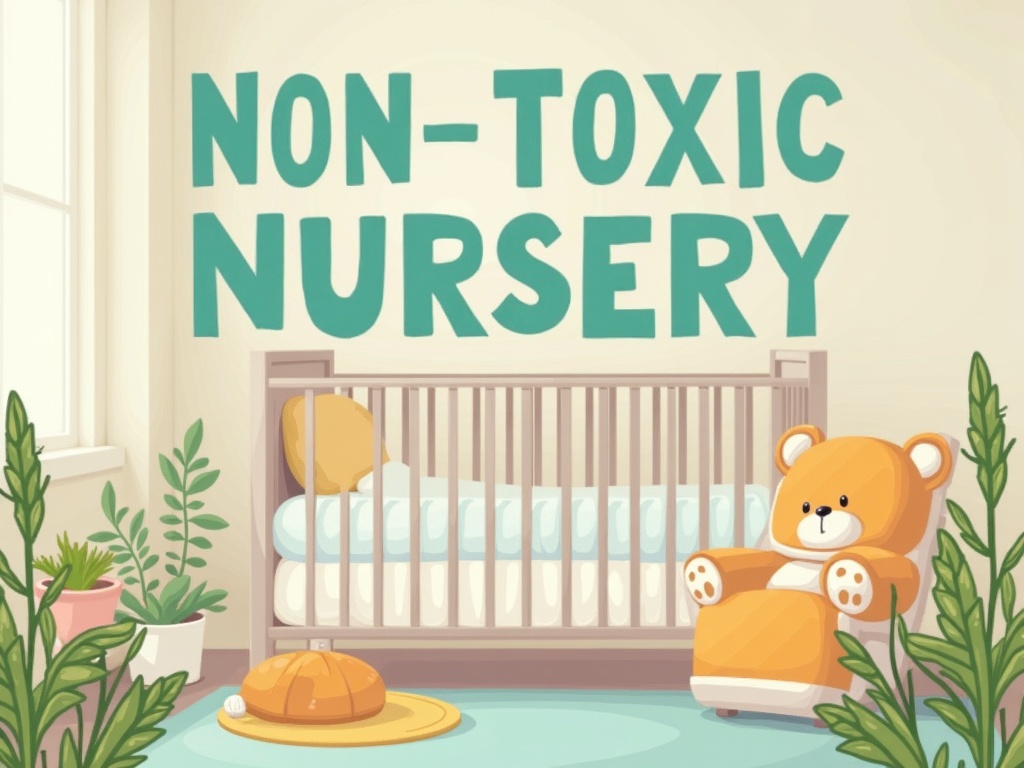Creating a Non-Toxic Nursery: A Guide to Safe and Healthy Beginnings
Imagine the purest, safest space for your new baby to dream, grow, and explore. A room free from harmful chemicals, allergens, and pollutants. This isn’t just a dream; it’s an achievable goal when you focus on creating a non-toxic nursery. Bringing a new life into the world is a momentous occasion, and ensuring their first environment is as healthy as possible is one of the greatest gifts you can give. Let’s dive into the steps you can take to create a safe haven for your little one.
Understanding the Importance of a Non-Toxic Nursery
Babies are particularly vulnerable to the effects of toxins. Their bodies are still developing, and they breathe faster, ingest more relative to their size, and have thinner skin than adults. This makes them more susceptible to absorbing harmful substances from their surroundings. Common chemicals found in nursery furniture, paint, flooring, and even bedding can off-gas, releasing volatile organic compounds (VOCs) into the air. These VOCs can contribute to respiratory problems, allergies, and other health issues. Creating a non-toxic nursery minimizes these risks and promotes a healthier start in life.
Choosing Non-Toxic Furniture
The crib, dresser, and changing table are the cornerstones of any nursery. Opting for furniture made from sustainable, non-toxic materials is crucial.
Selecting a Safe Crib
**Solid Wood:Look for cribs made from solid wood, such as birch, maple, or pine, that are sustainably harvested. Ensure the wood is finished with non-toxic, water-based paints or stains.
**Avoid MDF and Particleboard:These materials often contain formaldehyde, a known carcinogen. If you must choose furniture made with these materials, look for products that are CARB (California Air Resources Board) compliant, meaning they meet strict emissions standards.
**Check for Certifications:Look for certifications like GREENGUARD Gold, which indicates that the product has been tested and certified to have low chemical emissions.
Dressers and Changing Tables: Sustainability and Safety
**Solid Wood Construction:Similar to cribs, choose dressers and changing tables made from solid wood with non-toxic finishes.
**Consider Vintage or Secondhand:Refurbishing vintage furniture can be a sustainable and cost-effective option. Just be sure to sand and refinish it with non-toxic products.
**Secure Furniture to the Wall:Regardless of the material, always anchor dressers and changing tables to the wall to prevent tip-over accidents.
Non-Toxic Paint and Wall Coverings
The walls of your nursery play a significant role in the overall air quality. Choosing the right paint can make a big difference.
Low-VOC or Zero-VOC Paint
**What are VOCs?:Volatile Organic Compounds are chemicals that evaporate from paint into the air, contributing to indoor air pollution.
**Look for Labels:Select paints labeled as low-VOC or zero-VOC. These paints have significantly fewer harmful chemicals.
**Consider Natural Paints:Natural paints, made from ingredients like clay, milk, or plant oils, are an even safer alternative.
Wallpaper and Wall Decals
**PVC-Free Options:Traditional wallpaper can contain PVC (polyvinyl chloride), which releases harmful chemicals. Look for PVC-free wallpaper made from natural fibers or recycled materials.
**Non-Toxic Adhesives:Ensure that the adhesive used to apply wallpaper or decals is also non-toxic and low-VOC.
**Removable Wall Decals:These are a great way to add personality to the nursery without the commitment and potential toxins of traditional wallpaper. Choose decals made from fabric or other non-toxic materials.
Choosing Safe Flooring
The type of flooring you choose can also impact the air quality in your nursery.
Natural and Sustainable Options
**Solid Wood:Hardwood flooring is a classic and durable option. Choose sustainably harvested wood and finish it with a non-toxic sealant.
**Cork:Cork is a renewable resource that is naturally antimicrobial and hypoallergenic. It’s also soft and comfortable underfoot.
**Bamboo:Bamboo is another sustainable option that is durable and resistant to moisture.
**Avoid Vinyl and Laminate:These materials can contain PVC and formaldehyde. If you must use them, look for low-VOC options and ensure they are properly installed to minimize off-gassing.
Creating a Healthy Sleep Environment: Bedding and Linens
Your baby will spend a significant amount of time sleeping, so creating a safe and healthy sleep environment is paramount.
Organic Cotton Bedding
**Why Organic Cotton?:Conventional cotton is often treated with pesticides and chemicals during growing and manufacturing. Organic cotton is grown without these harmful substances.
**Look for Certifications:Choose bedding made from GOTS-certified (Global Organic Textile Standard) organic cotton. This ensures that the entire production process meets strict environmental and social standards.
**Avoid Synthetic Fabrics:Synthetic fabrics like polyester can trap heat and moisture, creating an environment conducive to bacteria growth.
Natural Fiber Fillings
**Wool, Kapok, or Buckwheat Hulls:These natural materials are breathable, hypoallergenic, and resistant to dust mites.
**Avoid Flame Retardants:Look for bedding that is free from chemical flame retardants. These chemicals can be harmful to your baby’s health.
Washing New Bedding
**Always Wash Before Use:Wash all new bedding before using it to remove any residual chemicals or dust.
**Use a Gentle, Non-Toxic Detergent:Choose a detergent that is free from dyes, fragrances, and harsh chemicals.
Air Quality and Ventilation
Maintaining good air quality in the nursery is essential for your baby’s respiratory health.
Regular Ventilation
**Open Windows Regularly:Whenever possible, open windows to ventilate the nursery and allow fresh air to circulate.
**Use an Air Purifier:Consider using an air purifier with a HEPA filter to remove dust, pollen, and other allergens from the air. Look for an air purifier that is ozone-free.
Houseplants
**Natural Air Purifiers:Certain houseplants, such as spider plants, snake plants, and peace lilies, can help to purify the air by absorbing toxins.
**Choose Safe Plants:Make sure to choose plants that are non-toxic to babies and pets.
Avoid Scented Products
**Fragrances and Air Fresheners:Avoid using scented candles, air fresheners, and other products that contain synthetic fragrances, as these can release harmful chemicals into the air.
**Use Natural Alternatives:If you want to add a pleasant scent to the nursery, consider using essential oil diffusers with pure, therapeutic-grade essential oils. Be sure to use them sparingly and choose oils that are safe for babies.
Non-Toxic Toys and Playtime
Babies explore the world through their mouths, so it’s crucial to choose toys that are safe and non-toxic.
Natural Materials
**Wooden Toys:Look for toys made from sustainably harvested wood with non-toxic finishes.
**Organic Cotton Toys:Plush toys made from organic cotton are soft, safe, and cuddly.
**Avoid PVC and Phthalates:These chemicals are commonly found in plastic toys and can be harmful to your baby’s health. Look for toys labeled as PVC-free and phthalate-free.
Cleaning Toys
**Regular Cleaning:Clean toys regularly with a non-toxic cleaner to remove dirt and germs.
**Homemade Cleaners:You can make your own non-toxic cleaner by mixing water with vinegar or baking soda.
Reducing Allergens
Creating a hypoallergenic nursery can help to prevent allergies and asthma in your baby.
Dust Regularly
**Use a Damp Cloth:Dust the nursery regularly with a damp cloth to remove dust mites and other allergens.
**Vacuum Frequently:Vacuum carpets and rugs frequently with a vacuum cleaner that has a HEPA filter.
Wash Bedding Regularly
**Hot Water:Wash bedding in hot water (at least 130°F) to kill dust mites.
**Hypoallergenic Mattress Cover:Use a hypoallergenic mattress cover to protect your baby from dust mites and other allergens.
Control Humidity
**Maintain Optimal Humidity:Keep the humidity level in the nursery between 30% and 50% to prevent mold growth.
**Use a Dehumidifier:If the humidity is too high, use a dehumidifier to lower it.
Practical Tips for a Non-Toxic Nursery
Here are some additional tips to help you create a non-toxic nursery:
**Air Out New Products:Before bringing new furniture, bedding, or toys into the nursery, air them out for several days in a well-ventilated area to allow any residual chemicals to off-gas.
**Read Labels Carefully:Always read labels carefully to check for potentially harmful chemicals.
**Choose Natural Baby Products:Opt for natural and organic baby products, such as diapers, wipes, lotions, and shampoos.
**DIY When Possible:Consider making your own baby products using natural ingredients.
**Trust Your Instincts:If something doesn’t feel right, don’t use it.
Creating a non-toxic nursery is an investment in your baby’s health and well-being. By carefully choosing materials, products, and practices, you can create a safe and healthy environment where your little one can thrive. While the prospect might seem daunting, remember that every small change contributes to a healthier space. Embrace the journey, trust your instincts, and enjoy the process of creating a nurturing haven for your child. The peace of mind knowing you’ve done everything possible to protect your baby is truly priceless.

